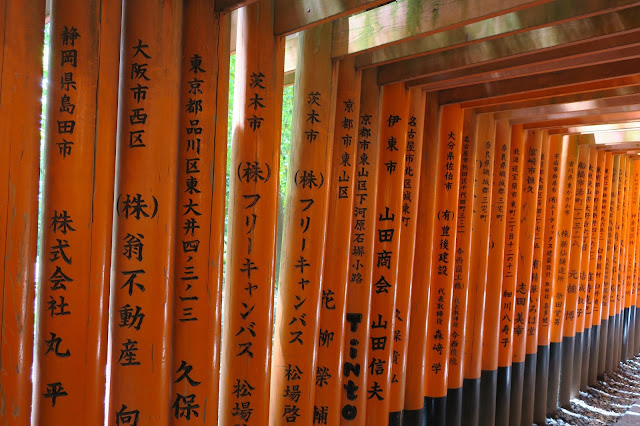At the beginning of the shrine complex are a couple of large entrance gates, as well as the main shrine building, both of which share the distinctive vermillion hue of the famous torii gates.
 |
Behind the main shrine building is where the torii trail up the forested mountain begins. The lower parts of the mountain were incredibly busy with tourists when I visited. I was disappointed at how crowded it was and wondered how on earth various friends of mine, who had visited previously, managed to get great photos of just themselves against the stunning backdrop of the red torii. However, as soon as you start to work your way up the mountain, it gets much, much quieter, and at many points we were quite alone and could enjoy the impressive sights in all their glory, unmarred by crowds. I think a lot of people don't bother hiking up and just stay at the bottom for a few token photos before getting back on their coach and being driven to their next destination.
The reason why there are so many red gates of varying sizes, is because each one has been bought as a donation to the shrine by either an individual or a business, in the hope of ensuring success and happiness. The bigger the torii, the greater the donation! The writing on the gates marks the name of the donor and the date of the donation. Some of the torii were quite old, with much of the brightness of the paint having faded and splits beginning to appear in the wood. Others were so shiny and bold in colour that they may well have been put up the day before I visited. Whether new or old, together the collection of torii certainly make an impressive sight, especially against the green backdrop of the forest. As the torii bend around a corner, they sometimes give the illusion of going on forever.
There are plenty of other things to capture the imagination along the hiking route, in addition to walking through the many torii gates. There are lots of smaller shrines at intervals along the trail. One of the recurring motifs is that of the fox, as these animals are associated with the god Inari. We even stumbled across a little bamboo grove, this one with far fewer visitors than the famous one at Arashiyama.
Roughly halfway between the starting point of the trail and the mountain summit, you reach a fantastic look out point where you can stop and catch your breath whilst enjoying a bird's eye view of Kyoto.
The whole hike to the summit and back is around 2 1/2 miles, with lots of steps and steep gradients, so it's a good idea to wear comfortable shoes and take some water with you, especially if it is a hot day. If you have forgotten your own refreshments, there are spots on the trail where you can stop for a drink or buy one to-go (and of course there are a scattering of vending machines, as is to be expected in Japan).
On the way back down from the summit we stopped at one of the small restaurants and ate udon on a tatami mat floor, which was served by an old lady who looked like she was pushing 90 years old. She still had it going on in the kitchen though.
 |
That was just enough fuel to get us back down to the bottom of the mountain. I think that is more or less all I can show and tell about my visit to Fushimi Inari. But you really have to go yourself to experience the magic of it.
I will write one more blog about a few attractions that I visited when in central Kyoto. Although I didn't enjoy the centre of the city as much as Arashiyama and Fushimi Inari, it still has plenty of museums (I particularly loved the new railway museum), temples, a wonderful market, and other sights to keep anyone entertained for a day or two.

















No comments:
Post a Comment